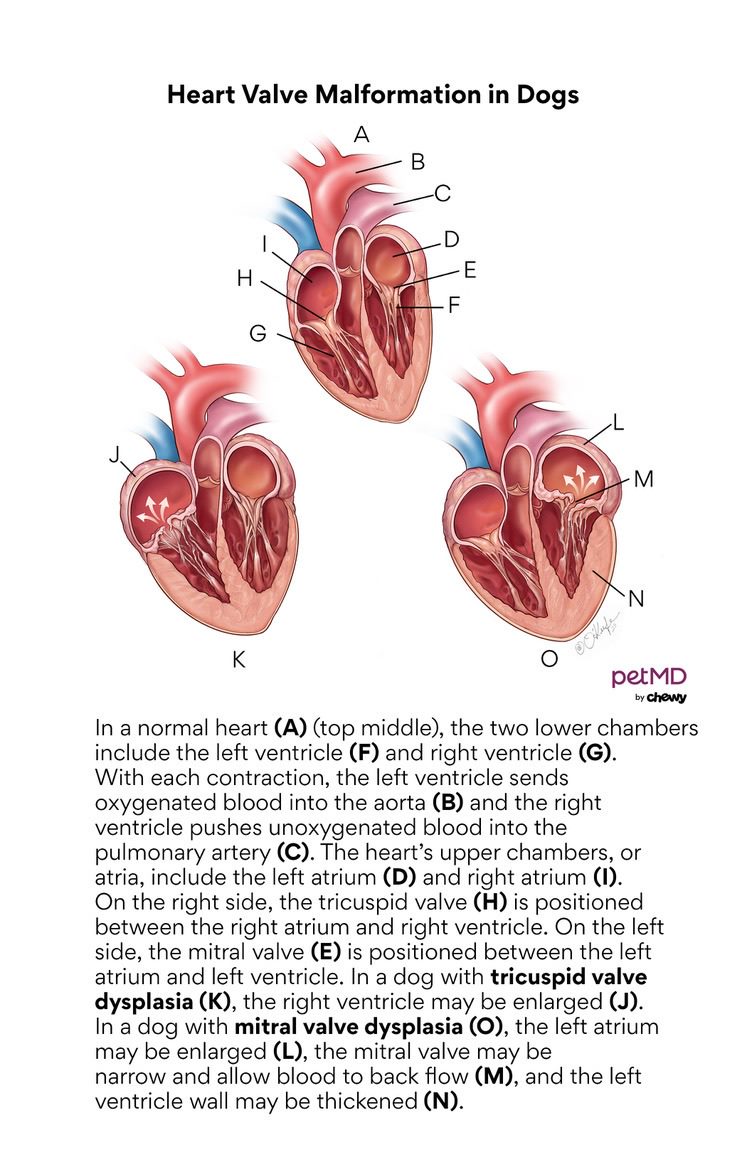Heart Valve Malformation in Dogs
What Is Heart Valve Malformation in Dogs?
Heart valve malformation, also termed atrioventricular valve dysplasia (AVD), is a condition that occurs because of a developmental malformation (abnormal structure) of the mitral or tricuspid valve. This causes the valves to not close appropriately to stop blood flowing across them. The valves are narrowed and can result in an obstruction of blood flow through the heart. Symptoms depend on the severity of the valve narrowing and location of the malformation.
Anatomy of a Dog’s Heart
A dog’s heart is composed of four chambers: two on top and two on bottom. The two top chambers are termed the atria, and the bottom two chambers the ventricles. The atrioventricular (AV) valves separate the four chambers. The valves open and close using leaflets to allow blood to flow from the atria to the ventricles in an orderly and smooth fashion, while the heart is beating.
The AV valve on the left side of the heart is called the mitral valve and has two leaflets. The AV valve on the right side of the heart is the tricuspid valve and has three leaflets. Low-oxygen blood from the body enters the right atrium, passes through the tricuspid valve to the right ventricle, then passes to the lungs to pick up oxygen. This high-oxygen blood returns to the left atrium, passes through the mitral valve to the left ventricle and then is pumped out to the body.
This is a cycle that is spontaneous and it is what keeps us alive. The job of the AV valves is to prevent the backflow of blood from the ventricles to the atria while the heart is contracting. If the valves are not properly functioning, blood can back flow and lead to congestive heart failure (CHF).
AV Malformations in Dogs
AV malformations are considered congenital abnormalities, meaning that they are present at birth and are often diagnosed in the first few years of life. They can be diagnosed later in life, if mild.
There are two main types of AV malformations:
-
Mitral valve dysplasia (MVD): This is a condition where the mitral valve becomes narrow, allowing a backflow of blood from the left ventricle to the left atrium, eventually affecting high-oxygen blood that flow to the lungs from the heart. The most common breeds predisposed to this condition are Bull Terriers, Dalmatians, German Shepherds, Golden Retrievers, Great Danes, Mastiffs, Newfoundlands, and Rottweilers.
-
Tricuspid valve dysplasia (TVD): This is a condition where the tricuspid valve becomes narrowed, allowing a backflow of blood from the right ventricle to the right atrium, eventually affecting low-oxygen blood flow returning from the body back to the heart. The most common breeds predisposed to this condition are Boxers, Dogue de Bordeaux, German Shepherds, Great Danes, Great Pyrenees, Irish Setters, Labrador Retrievers, Old English Sheepdogs, and Weimaraners.
AVD leads to the atria on the affected valve side which enlarges (dilates) the ventricle. Eventually, this causes volume overload and affects blood flow, leading to fluid buildup in the lungs and/or the abdomen (CHF).

Symptoms of Heart Valve Malformation in Dogs
Symptoms of AVD can range from non-existent early in the disease to severe. These signs usually begin within the first 1 to 2 years of life. Heart murmurs, or an abnormal “whooshing” noise when the vet listens to the dog’s heart with a stethoscope, are usually heard.
Clinical signs vary, depending on the AV valve affected. MVD clinical signs include:
-
Coughing
-
Tiring easily during exercise
-
Increased respiratory rate or effort
-
Abnormal coloration to the gums (blue/gray)
-
Collapse, weakness, or fainting
TVD clinical signs include:
-
Stunted growth
-
Tiring easily with exercise
-
Abdominal distention due to fluid accumulation
-
Collapse, weakness, or fainting
Causes of Heart Valve Malformation in Dogs
There is no proven cause of these malformations, but they are thought to be caused by genetic mutations, poor nutrition while in the uterus, infections while in the uterus, and some medications administered during pregnancy. Vets suspect that these AV defects are inherited based on predisposed dog breeds.
How Veterinarians Diagnose Heart Valve Malformation in Dogs
Diagnosis is based on history of clinical signs, and sometimes looking into your dog’s lineage. Your vet will also take bloodwork, blood pressure, and radiographs to assess heart’s size, the blood vessels going to and from the heart, and the lungs or abdomen to analyze any fluid accumulation.
For a definite diagnose of AVD—and to assess fluid accumulation—a veterinarian may recommend an echocardiography (ultrasounds of the heart). This “gold standard” test will help diagnose and monitor the progression of heart disease in dogs.
An electrocardiogram (EKG or ECG) may be performed to assess the electrical function of the heart and to rule out any cardiac arrhythmias (abnormal heart rhythms). Evaluating heart rhythm can often help determine which side of the heart the disease initiated.
Treatment of Heart Valve Malformation in Dogs
Treatment of AVD focuses on management of clinical signs since there is no current cure for AVD. Usually, this means treating and managing CHF. In severe cases, this includes hospitalization with oxygen therapy, diuretic therapy, and in right-sided CHF, removal of abdominal fluid for relief.
Oral medications are often used once changes to the heart chambers are noted or CHF is diagnosed, and these are usually life-long medications. Oral medications include diuretics, ACE inhibitors, and Pimobendan. Anti-arrhythmic medications may be needed in some cases. The veterinarian will often recommend exercise restrictions and sodium reduction to your dog’s diet.
Artificial tricuspid valve replacements have been attempted—but often fail because of complications. This surgery is often not feasible because of cost and lack of availability.
Recovery and Management of Heart Valve Malformation in Dogs
Unfortunately, the long-term prognosis for AVD is unknown-to-poor depending on the severity of the condition. Prognosis worsens once a pet enters the stage of congestive heart failure.
Dogs diagnosed with this condition are often on life-long cardiac medications and need frequent visits to the veterinarian (or a board-certified cardiologist) to monitor progression of the disease. Medications may be added or changed, depending on how the condition progresses.
Dogs diagnosed with AVD often require decreased stress, decreased exercise, and changes in their nutrition to decrease sodium, and to assure foods contain the right amino acids and nutrients. These dogs should never be used for breeding as vets suspect these conditions are inherited.
Heart Valve Malformation in Dogs FAQs
How long can a dog live with heart valve disease?
Dogs with mild disease can live normal life spans. Dogs with more severe disease of the valves may only survive up to 1-2 years.
Featured Image: iStock.com/PixelsEffect
Help us make PetMD better
Was this article helpful?
